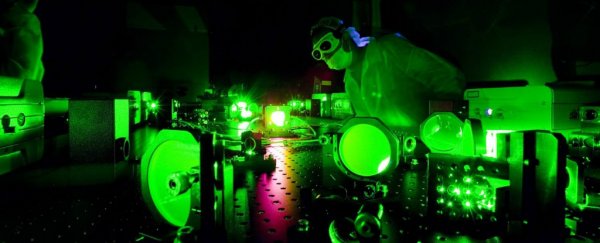Researchers have just published the results of an experiment creating the brightest light ever produced on Earth – shining as bright as a billion of our Suns.
This research, although just incredibly awesome, also has implications for a new type of X-ray, and confirming some of the basics of electrodynamics.
"There were many theories, for many years, that had never been tested in the lab, because we never had a bright-enough light source to actually do the experiment," said Donald Umstadter, the lead researcher on the project.
"There were various predictions for what would happen, and we have confirmed some of those predictions."
The physicists, from the University of Nebraska-Lincoln, used the DIOCLES laser, one of the most powerful lasers in the US, to create the ultra-bright light.
The team fired the laser at helium-suspended electrons to see how the photons scatter from a single electron each time it's struck.
Let's jump back a bit though – in typical light conditions, photon scattering makes vision possible, but electrons usually only scatter one photon at a time.
Some previous laser experiments have scatted a couple of photons from the same electron – but this new experiment scattered nearly 1,000 photons at once!
And to top it off, the scattering was so intense that it actually changed objects appearances.
"When we have this unimaginably bright light, it turns out that the scattering – this fundamental thing that makes everything visible - fundamentally changes in nature," said Umstadter.
So instead of a photon scattering at the same angle and energy before and after it hit the electron, which it would from a normal light source, the super bright laser altered that angle and energy.
"So it's as if things appear differently as you turn up the brightness of the light, which is not something you normally would experience," Umstadter said.
"[An object] normally becomes brighter, but otherwise, it looks just like it did with a lower light level. But here, the light is changing [the object's] appearance."
"The light's coming off at different angles, with different colours, depending on how bright it is," he added.
All of this is super cool, but where do X-rays come into it?
Well, when an electron is hit with the bright laser beam, it actually ejects its own photon.
This single photon carries with it the combined energy of all of the photons that smacked into that electron – giving the photon the equivalent energy and wavelength of an X-ray.
The team is hoping that these special X-ray photons could be used to hunt for tumours that current X-rays are not able to see, create an ultrafast camera to snap electron motions and chemical reactions, or just create 3D images of nanoscopic objects.
But for the meantime, we might just bask in the knowledge that the brightest light ever has been created in a lab, it makes electrons do super weird things, and we still have so much to learn about the basics of our world.
The research has been published in Nature Photonics.
